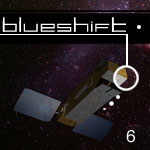Podcast: A NASA New Year!
- By Sara Mitchell
- January 2, 2008
- Comments Off on Podcast: A NASA New Year!
 Click to listen! (9MB MP3, right-click to save)
Click to listen! (9MB MP3, right-click to save)
Transcript (Text, PDF)
Welcome to the December 2007 episode of Blueshift, from NASA Goddard Space Flight Center. We’re celebrating the new year with a look at the typical life cycle of NASA missions and the typical day of our science staff.
We’ll start with a look back at the FUSE mission, which ceased operations earlier this year. Then we’ll give you an inside look at what it takes to make a mission happen – from the birth of ideas to the day-to-day operation of a satellite after launch.
- Introduction (0:00 – 1:09)
- Interview: George Sonneborn and FUSE (1:10 – 3:12)
A look back at the discoveries of the FUSE satellite over the last 8 years – and what’s coming next. - Featured Story: Life Cycles of Missions (3:13 – 9:00)
Where do these missions come from? What does it take to get from the drawing board to the launch pad? - Audio Scrapbook: Day in the Life (9:01 – 11:56)
Wander our hallways and find out what’s happening in a typical day around here. - Closing (11:57 – 13:09)
Interview: George Sonneborn and FUSE
Eight years after launch, the Far Ultraviolet Spectroscopic Explorer, or FUSE, ceased operations. With 130 million seconds of data in its science archive, FUSE will continue to fuel new discoveries. To find out more about the mission, visit:
- The Far Ultraviolet Spectroscopic Explorer homepage at Johns Hopkins University
- FUSE is Dead…Long Live FUSE! – The final mission status report for the mission (October 18, 2007)
Featured Story: Life Cycles of Missions
In this story, we wanted to give you an idea of where mission ideas come from, and what happens to those ideas as they are developed, built, and launched. While no missions are identical, there is a process that most follow – so we visited scientists working on satellites in different stages. Here are sites about the specific missions we highlighted:
- James Webb Space Telescope – Scheduled for launch in 2013, Webb is currently under development at Goddard Space Flight Center.
- Gamma-ray Large Area Space Telescope – GLAST is undergoing its final round of testing, and will soon be shipped to Cape Canaveral for launch in May 2008.
- Swift – Launched in 2004, the Swift satellite is looking for gamma ray bursts and pointing other satellites at these mysterious events.
Audio Scrapbook: Day in the Life
Gail Rohrbach went up and down the hallways of our building for these interviews, to find out what people do on a typical day in the Astrophysics Science Division. Here are the people she interviewed, and information about some of the work they are doing.
- Padi Boyd – Padi is a team leader on two NASA missions – the Swift satellite and the Rossi X-ray Timing Explorer (RXTE). Both missions are currently in orbit and returning data to Earth, which makes Padi a very busy person.
- Craig Markwardt – Craig works on the Swift mission, an orbiting satellite that detects Gamma Ray Bursts. Craig helped develop the Burst Alert Telescope (BAT) on-board Swift.
- Simon Bandler – Simon is a part of the Microcalorimeter group in the X-ray Astrophysics Laboratory. His paper was presented at the Society of Photo-optical Instrumentation Engineers (SPIE) conference.
- Stephen Holland – Stephen studies Gamma Ray Bursts primarily with the Ultra-Violet/Optical Telescope on board the Swift satellite. The optical and X-ray emission seen after a Gamma Ray Burst is called the “afterglow,” which is what Stephen (and Frank Marshall, the next speaker) is studying.
- Frank Marshall – Frank is the Ground System Manager for Swift, which means he oversees the collection and processing of Swift data once it reaches Earth. When he’s not doing that, he tries to spend some time investigating the Gamma Ray Bursts found by Swift, and the “afterglows” from those bursts.
- Caroline Kilborne – Caroline is another member of the X-ray microcalorimeter group. She’s helping to develop detectors that will be used on the Constellation-X observatory, scheduled for launch in 2018.
- Koji Mukai – Koji works on the Suzaku mission, a joint U.S./Japanese X-ray telescope in space. He is assembling a catalog of Cataclysmic Variables, a type of binary star system that emits X-rays.
- Eric Winter – Eric is a programmer and PhD candidate working for the Gamma-ray Large Area Space Telescope (GLAST), which is scheduled to launch in 2008.
- Pat Tyler – Pat is a computer wiz, who has probably never met a piece of software she can’t master. She works on many missions and projects, often designing graphics and Web sites such as this one for Beyond Einstein.
- Robin Corbet – Robin is in charge of operations for the Gamma-ray Large Area Space Telescope (GLAST) Science Support Center.
- Padi Boyd – We started with Padi talking about her day, and we come back to her at the end; as noted above, a very busy person!
Credits:
| Hosts | Steve Fantasia Sara Mitchell |
| Interview with George Sonneborn | Joel Offenberg |
| Featured Story | Anita Krishnamurthi Sara Mitchell |
| Audio Scrapbook | Gail Rohrbach |
| Guests | Simon Bandler Padi Boyd Robin Corbet Jonathan Gardner Joe Hill Stephen Holland Caroline Kilborne Craig Markwardt Frank Marshall Koji Mukai George Sonneborn Dave Thompson Pat Tyler Eric Winter |
| Theme Music | Naked Singularity |
| Other Music | Outta Scope |
| Editors | Anita Krishnamurthi Maggie Masetti Sara Mitchell Joel Offenberg Gail Rohrbach |
| Producer | Sara Mitchell |
| Executive Producer | Anita Krishnamurthi |
| Responsible NASA Official | Kim Weaver |


